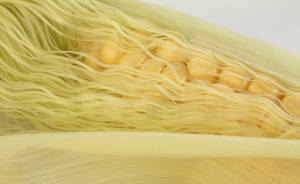Corn has been a major part of agriculture the world over for centuries. It is grown by commercial growers for its byproducts as well as the for the food itself. Sweet corn is a warm season crop that will not tolerate frosts. Otherwise, it can tolerate most climates.
Varieties of Sweet Corn
There are a few groups of sweet corn. Traditional or standard varieties are your stock standard sweet corns. Sugary Extender and Supersweet varieties are, predictably, sweeter than normal. There are also some varieties known as Synergistic which combine various properties of them all. There are also some popcorn varieties and ornamental varieties that have a huge variety of almost unthinkable colors, including blue! The most important factor to consider for a home gardener is the length of the growing season. There are fast maturing varieties available if your climate will not be able to provide 4 months of warmth between 15°C and 35°C (60°-90°F). Different varieties of corn also cross-pollinate, resulting in a poorer quality corn, so it’s a good idea to either separate different varieties or only grow the one.
Planting Sweet Corn
Sweet corn is more sensitive to soil temperature when planting than many other vegetables. Ideally soil temperatures will be at least 15°C when sowing. Sweet corn can tolerate high heat and continues to flourish even at 35°C. Drier climates are preferable but it will grow just fine in tropical climates and can be sown the year round. Soil should be prepared using organic matter 3-4 weeks before sowing seed. pH should be between 5.5 and 7. As roots are quite deep, the soil will ideally be stone free. Sow 2-3 seeds in stations 12 inches apart initially, thinning to about 2 feet (60cm). Rows should be 4 feet (1.2m) apart. As corn is pollinated by wind, it is a good idea to sow in a square plot rather than in true rows, so use the aforementioned spacing but don’t make the rows too long. Keep in mind that sweet corn plants are very large and may shade other parts of your garden, which can be a blessing or curse depending on what it is shading. Preparing the soil with a bit of nitrogenous fertilizer is advisable. Place it in the bottom of the rows and backfill with a few inches of soil. Plant the seeds, cover with soil, rake and mulch.
Growing Sweet Corn
It takes about 2 weeks for seed to germinate. Sweet corn is very hungry for water, especially in the early stages of growing. Ideally drip irrigation will be used, but if not aim to water twice a day. Use a mulch to maintain moisture. The highest rates of pollination can be achieved by planting in a square as described above and by hand pollinating. Do this by simply shaking or tapping the corn so that it pollinates other plants. This is especially important if your garden has very little wind. Supporting plants with trellising may be necessary in very windy sites, but they generally do fine on their own.
Harvesting Sweet Corn
Sweet corn takes 10-15 weeks to mature, depending on the variety. It will grow faster in warmer climates. Corn will tell you when it is ready to be picked by its silks (the silky strands off the plant) turning brown. The old thumbnail test will confirm if the cob is tender enough – if you can pierce a grain then pick away! Simply twist each cob off the plant.
Something to be wary of when harvesting sweet corn is the sugar turns to starch quite quickly. The sugary extender and supersweet varieties’ sugar lasts a few days longer, but generally 1-3 days is as long as they last. If not eating straight away, corn can be frozen easily. Blanch cobs whole for 5 minutes, wrap them in film and place in the freezer.
Threats to Sweet Corn
Try and choose a variety that is resistant to disease. Worms and beetles may get to your crop every so often. Sometimes they find their way in to the corn cobs themselves and need to be chemically controlled. Fungal diseases occur occasionally, especially in wet areas.

